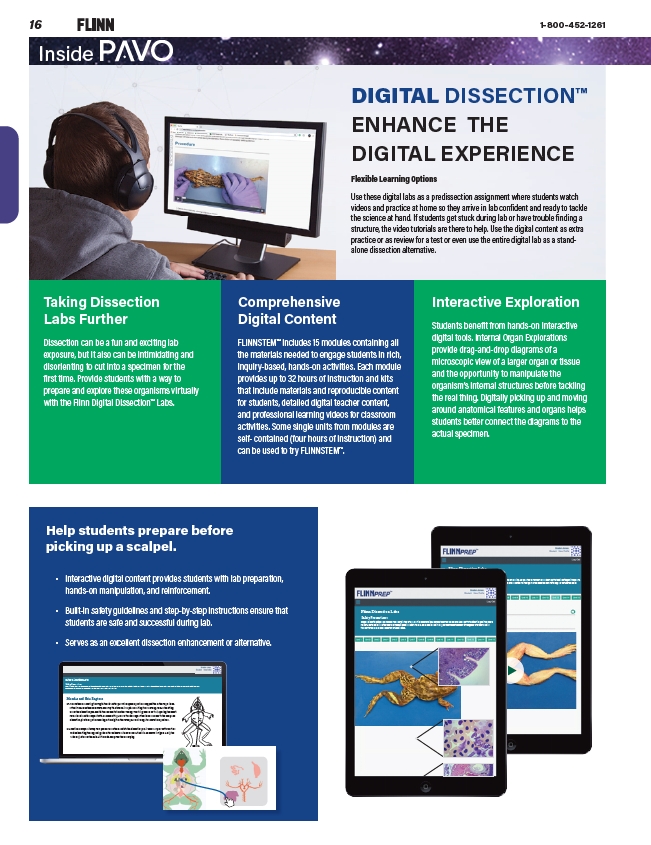
16 1-800-452-1261
DIGITAL DISSECTION™
ENHANCE THE
DIGITAL EXPERIENCE
Flinn Dissection Labs
Safety Precautions
Scalpels, dissecting scissors, and needles are all sharp instruments; use caution when handling. Always cut away from yourself and others. Rotate the dissection pan, if necessary,
for better control while dissecting. Wear safety glasses, chemical-resistant gloves, and a chemical-resistant apron. Wash hands thoroughly with soap and water before leaving
the laboratory. Please follow all laboratory safety guidelines.
Procedure
Flinn Dissection Labs
Safety Precautions
Scalpels, dissecting scissors, and needles are all sharp instruments; use caution when handling. Always cut away from yourself and others. Rotate the dissection pan, if necessary,
for better control while dissecting. Wear safety glasses, chemical-resistant gloves, and a chemical-resistant apron. Wash hands thoroughly with soap and water before leaving
the laboratory. Please follow all laboratory safety guidelines.
Procedure
Help students prepare before
picking up a scalpel.
• Interactive digital content provides students with lab preparation,
hands-on manipulation, and reinforcement.
• Built-in safety guidelines and step-by-step instructions ensure that
students are safe and successful during lab.
• Serves as an excellent dissection enhancement or alternative.
Flinn Dissection Labs
Safety Precautions
Scalpels, dissecting scissors, and needles are all sharp instruments; use caution when handling. Always cut away from yourself and others. Rotate the dissection pan, if necessary, for better control while dissecting. Wear safety glasses, chemical-resistant gloves, and a chemical-resistant apron. Wash
hands thoroughly with soap and water before leaving the laboratory. Please follow all laboratory safety guidelines.
Point A
Muscles and Skin Regions
M1. The method of securing the frog to the dissection pan will depend upon the body position of the frog’s limbs.
If the limbs are extended forward, securely tie a twelve-inch piece of string to one foreleg. Thread the string
under the dissection pan and tie the free end to the other foreleg. The string should be taut, opening the chest
for easier dissection. Repeat with a second string around the hind legs. If the limbs are close to the body, use
dissection pins through the webbing of the digits of the forelegs and hind legs to secure the specimen.
M2. Caution: Always cut away from yourself and others. Rotate the dissection pan, if necessary, for better control
while dissecting the frog. Using dissection scissors cut a small hole at Point A as shown in Figure 4. Slip the
scissors just under the skin. Lift the skin away from the underlying
Flexible Learning Options
Use these digital labs as a predissection assignment where students watch
videos and practice at home so they arrive in lab confident and ready to tackle
the science at hand. If students get stuck during lab or have trouble finding a
structure, the video tutorials are there to help. Use the digital content as extra
practice or as review for a test or even use the entire digital lab as a standalone
dissection alternative.
Taking Dissection
Labs Further
Dissection can be a fun and exciting lab
exposure, but it also can be intimidating and
disorienting to cut into a specimen for the
first time. Provide students with a way to
prepare and explore these organisms virtually
with the Flinn Digital Dissection™ Labs.
Comprehensive
Digital Content
FLINNSTEM™ includes 15 modules containing all
the materials needed to engage students in rich,
inquiry-based, hands-on activities. Each module
provides up to 32 hours of instruction and kits
that include materials and reproducible content
for students, detailed digital teacher content,
and professional learning videos for classroom
activities. Some single units from modules are
self- contained (four hours of instruction) and
can be used to try FLINNSTEM™.
Interactive Exploration
Students benefit from hands-on interactive
digital tools. Internal Organ Explorations
provide drag-and-drop diagrams of a
microscopic view of a larger organ or tissue
and the opportunity to manipulate the
organism’s internal structures before tackling
the real thing. Digitally picking up and moving
around anatomical features and organs helps
students better connect the diagrams to the
actual specimen.
Inside